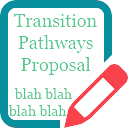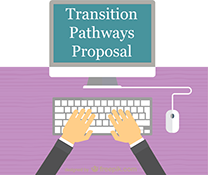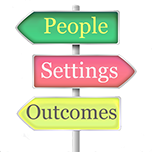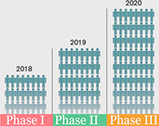Partnerships in service delivery that advance scholarship through implementation
Promoting services in a research institute: Key strategies, stumbling blocks, and risks
December 20, 2018
 Most of the chapters in the story of the Transition Pathways Proposal focus on the innovations in developing programs of services that I was seeking to test further. This chapter focuses on what researchers might consider the greatest innovation, but what the rest might argue is simply long-overdue: how a university-based research institute can broaden its focus to include the demonstration of effective services leading to meaningful life outcomes. This requires understanding the difference between (a) traditional research that generates value through scientific publications that may lead to more grants, and (b) innovative implementation that generates value through other forms of scholarship and service to the university and community at large. How do you accomplish this shift within the university and the community, and among donors and key stakeholders? What problems await researchers who underestimate what is required for service delivery to be truly innovative? What are the key strategies and stumbling blocks, and biggest risks for faculty members seeking to lead such efforts?
Most of the chapters in the story of the Transition Pathways Proposal focus on the innovations in developing programs of services that I was seeking to test further. This chapter focuses on what researchers might consider the greatest innovation, but what the rest might argue is simply long-overdue: how a university-based research institute can broaden its focus to include the demonstration of effective services leading to meaningful life outcomes. This requires understanding the difference between (a) traditional research that generates value through scientific publications that may lead to more grants, and (b) innovative implementation that generates value through other forms of scholarship and service to the university and community at large. How do you accomplish this shift within the university and the community, and among donors and key stakeholders? What problems await researchers who underestimate what is required for service delivery to be truly innovative? What are the key strategies and stumbling blocks, and biggest risks for faculty members seeking to lead such efforts?
How is a proposal to demonstrate innovative services different from a traditional research grant?
It is evaluated on the likelihood and extent of impact, not its power to detect differences
Instead of aspirations that research findings may eventually somehow translate into a better quality of life of people with ASD, the program of services that I proposed offered an immediate impact. For this project, I framed specific outcomes in terms of immediate, concrete improvements in quality of life for specific clients. This project built on the best available empirical science, by specifically addressing gaps identified through research and using practices and programs that researchers considered to be promising. But this proposal went beyond the available research, by proposing to demonstrate how to lay a foundation for sustained regional growth in capacity.
Researchers often justify the support requested by presenting power analyses to demonstrate the number of participants needed for each hypothesis and phase of a research study. Instead, the power of our study was expressed in terms of the number of young adults from traditionally under-served groups who would become able to achieve important life outcomes. In place of hypotheses, I proposed to demonstrate how a program becomes accessible, sustainable, replicable, and eventually scalable. Over time, I sought to maximize the number of young adults served, decrease the cost per participant, increase the number of replication sites, and build the capacity of community partners.
It pivots on the experience and expertise of practitioners and programs, not on the record of research publications
A traditional research grant often pivots on the research qualifications of the principal investigator(s), as demonstrated by the record of grants and peer-reviewed publications describing previous research projects. In contrast, our proposal to demonstrate and then replicate a new program of community-based services pivoted on the strength of our core team and our partner agencies. Instead of relaying the qualifications of a research team, I focused on the the expertise of our professionals in training and service delivery, and our plans for nurturing comparable expertise among the participating professionals in our partner agencies. Instead of a record of peer-reviewed research publications, I offered a broader record of books, chapters, and other articles documenting scholarship in the design and delivery of services.
For this kind of project, the design, implementation, achievable outcomes, and potential for generalization and replication depended entirely on the quality of professionals involved. The goals I set, the timelines I established, the specific staffing ratios I established, and the amount of training and coaching I anticipated that these professionals might require were based on careful estimates of their skills and experience. Newcomers to this kind of work invariably over-estimate the training and experience that the professionals they might recruit are likely to bring to this kind of project. They are especially likely to overestimate the availability of leaders with the kind of training and experience needed to undertake comprehensive program development.
In fact, for this project I began by working backwards from a conservative estimate of the kinds of professionals I expected we might recruit, then factored in how we might grow their expertise through training. Having recruit and trained professional staff across the region over the past decade, ranging from special education teachers to child psychiatrists, I was acutely aware of the type of experience each was likely to bring. I developed parallel estimates for the initial training and ongoing supervision they might need, and who might provide this. Only then did I develop a timeline for how the project might expand and improve. The detailed descriptions of the background and responsibilities of team members overseeing, delivering, and supporting services were essential to this process.
The importance of this step cannot be over-estimated. The potential to generalize and replicate this program depended entirely on our ability to understand and engage community-based agencies and professionals as true partners and leaders in their own right. If we overestimate their skills, resources, and motivation, we can set unrealistic goals that can drain their motivation. If we under-estimate these, we will never fully harness their potential for growth and change.
It focuses on achieving real improvements in outcomes and increased capacity, not just adding to our knowledge
In the case of the Transition Pathways Proposal, the evolving conversation with the donor was important in clarifying their driving interest in achieving real outcomes right now for young adults in the spectrum. This was important, as this donor has a long history of supporting research, and was adamant that this gift should directly support services and not focus on research. Specifically, they were eager to demonstrate how a university like Drexel might spur new programs of services that create new opportunities for employment, independent living, and higher education for young people on the spectrum transitioning into adulthood. I would not be surprised to discover other philanthropists who, having already supported research, may shift their priorities to piloting new services, especially if previous gifts never resulted in demonstrable improvements in outcomes.
The decision to focus on developing innovative programs of services that would expand capacity and achieve immediate outcomes had cascading effects not simply on the shape of the project, but on the nature of the proposal itself. For example, instead of reviewing the literature to identify how this proposal might contribute to new knowledge and advance the field, I reviewed models of comparable services available elsewhere across the country to identify their strengths and limitations. This revealed that a college-based program that was accessible to traditionally under-served youth, that focused equally on employment AND post-secondary learning, and that demonstrated how to expand though replication and systematically, would significantly improve outcomes and increase capacity.
I also reviewed gaps in the region and specific opportunities for our partners. This revealed that Drexel had neither established a program nor created partnerships with regional providers to promote hiring people with ASD (or, for that matter, with any developmental disabilities). This also revealed that Drexel's programs for supporting students on the autism spectrum had just been significantly downsized, despite the general consensus that there was a pressing need for both growth and improvement. These reviews therefore identified immediate and important opportunities that a literature review never would have.
Instead of generating testable hypotheses from this literature, I developed goals and told stories about how the proposed program could change the lives of people I had observed or spoken with. For example, I visited programs across the region,observed transition-aged youth on the spectrum, and talked with leaders about the outcomes they had achieved or had only dreamed of.
Perhaps the most compelling was a visit to an inner-city program operated by our public school partner. While the students preparing to graduate clearly had potential to work and live independently, it was clear that leaders of that school would have to climb mountains to provide these students with the opportunities they deserved, given the barriers that these school leaders had to overcome. These were exactly the kinds of under-served youth at the highest risk for the dismal outcomes documented in the National Autism Indicators Reports. And I spoke with many others: Drexel students on the spectrum who had struggled to succeed because of the lack of support; other students on the spectrum who offered invaluable insights into what might work; a father living next to Drexel whose own son on the spectrum had attended a college with programming specific to ASD, but that fell far short of expectations, and so on. In the final proposal, I collapsed these into the stories of Alisha and Dante (see sidebar), in place of the more traditional tables of statistics favored by researchers.
Instead of establishing credibility by attaching a bibliography of peer-reviewed publications in related topics, we established credibility by soliciting feedback on a project summary shared with other successful program leaders in the region and across the country. We identified other experts in advocacy, post-secondary education, and employment, and provided a summary of the proposed project to them. An independent agency conducted detailed interviews with these experts and summarized the findings, which were integrated into the final proposal. The enthusiasm of prospective partners also provides a measure of credibility.
It results in a business plan, not a research proposal
In the end, we did not create a research proposal that promised to yield new knowledge but we proposed a plan to create more opportunities for more adults. In fact, many of the elements listed above and described in other chapters parallel a business plan: a "market" study of the needs among young adults on the spectrum; the decision to immediately and directly target the untapped "market" of traditionally under-served groups; an analysis of gaps in the existing array of services; an assessment of the staffing and other resources needed to develop new services; the creation of strategic partnerships with other agencies; the calculation of costs per student and how to bring these down over time, and; long-term planning to sustain, expand, and replicate the proposed program.
Framing the proposal as a business plan has other interesting implications. For example, philanthropy is often born from a successful business, and so a philanthropist is more likely to recognize opportunities framed as a business plan with immediate and tangible benefits than a research proposal that aspires to add to a body of knowledge. Indeed, the development of the proposal may tap into the expertise of a philanthropist in overlapping areas, like how to conduct a market study, how to identify and nurture strategic partnerships, and so on.
Framing our proposal as a business plan is instructive for another important reason discussed earlier: it underscores the tremendous gap in funding for significant new programs of services. The vast majority of community-based programs have neither the funding nor the expertise that take on this challenge themselves. Our proposal therefore also demonstrates a unique role for philanthropy in program development, to act both as an incubator and as an accelerator.
Related Content
Replace hypotheses with stories of what we hoped to achieve
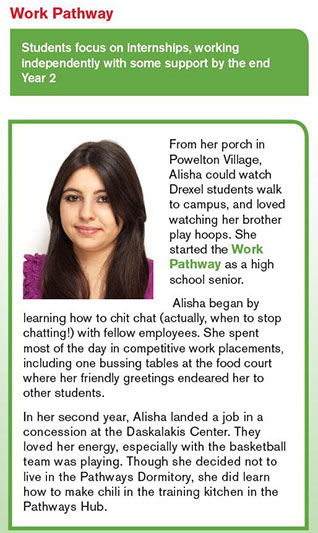
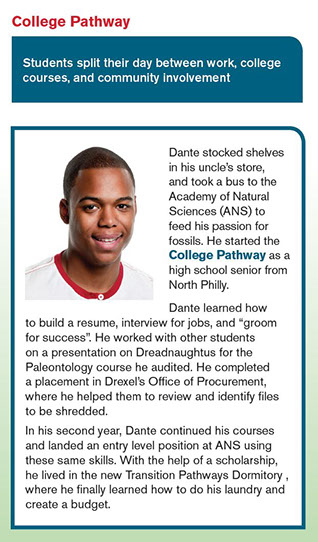
What are the Key Strategies, potential Stumbling Blocks, and big Risks to promoting services in a research institute?
Align services targeted by the proposal with the University's mission
Except for integrated diagnostic clinics in affiliated hospitals, universities have been slow to recognize synergy with the other services they already provide. This is especially true for young adults with ASD. For example, universities are also large employers (sometimes the largest employer in town). As such, they provide ready opportunities to employ people with disabilities generally, and those with ASD specifically. As large and (presumably) progressive employers, most universities should already have some coordinated program for employing people with developmental disabilities. Project Search, already offered in hospitals across the country, offers one model for how to do just that.
Likewise, universities already have academic services intended to help students with special learning needs. Some already have special programs already tailored to students with ASD. A proposal to provide a college experience to transition-aged youth outside of traditional academic programs (as demonstrated through ThinkCollege programs) can be framed as a downward extension of existing services.
Identify a major partner who can help shoulder the burden of delivering services
A research center is much better off partnering with an existing, community-based service provider than just creating a program of services in-house. Why?
- The provider can tap into a pool of existing p, some of whom might sometimes be very experienced
- The provider already has a pipeline of clients
- The provider has the infrastructure for hiring and supporting staff
- The provider offers a real-world laboratory that helps to immediately generalize results to typical settings
- A large provider can help to immediate test strategies for capacity-building.
Most importantly I believe that these community-based programs of education and health services constitute the backbone of our infrastructure, and their expertise is too-often overlooked. Engaging them as full partners reaffirms their value. Better still, actively building expertise within a community-based provider agency is the first step towards increasing overall system capacity.
A center does not want to extend its reach beyond research
I have encountered many academic settings that, for various reasons, view the any provision of services, even for the purposes of demonstrating new techniques, as outside of their mission. This reluctance is understandable - indeed, it is probably prudent - in the case of a faculty member with no training in delivering services. This reluctance is also understandable in the case of a faculty member who may have be trained to deliver services but has limited experience in actually doing so.
The rationale for expanding their activities to pilot service delivery is addressed elsewhere throughout this site; that ASD research can no longer just pursue knowledge through scientific inquiry, but must produce outcomes through action. Over the coming decade, the need to demonstrate that research can and must begin to have a real and immediate impact will become impossible to ignore. And this pivot towards social impact will require changes to both the model of science and the business of ASD research.
How does experience developing programs of services factor into decisions to promote faculty?
An ambitious faculty member who devotes their time to demonstrating the development of new services in the community that have a real impact may be risking their prospects for academic advancement. Why? Because they will probably publish less, or in less prestigious journals. Simply put, It is difficult to structure a service-oriented project to yield the kinds of controlled research that journals have come to expect. Such projects may not include opportunities to create control groups, conduct standardized assessments, deliver manualized treatments, or even recruit enough participants. This resulting lack of publications has cascading effects on their ability to access traditional research grant funding, which leads to fewer publications.
The greatest irony is that the more traditional researcher - i.e., those who seek only to generate more publications and more grants regardless of their actual impact on the lives of people with ASD - is more likely to be promoted into positions where they will evaluate the applications for promotion of these more ambitious faculty. And so traditional researchers who do not recognize the challenges - or even the need - to demonstrating programs of services are the ones most likely to decide which faculty are promoted. This can create death spiral to the academic career of ambitious researchers.
Researchers and centers risk over-stating just how just innovative a new program of services really is
A shift by a university-based ASD research center to pilot any new program of services can seem so revolutionary that it is tempting to hail this as innovative. While such a shift is indeed revolutionary in the universe of other research centers, that does not mean that the services themselves are necessarily innovative. Indeed, most of the claims that I have seen research centers make about the services they pilot overstate how innovative these services are.
There are several issues here. For example, I have found many researchers who do not appear to understand what work has already been done elsewhere. Sometimes the researchers fundamentally misunderstand how services are typically delivered, and so may overstate the impact of a relatively minor addition or change. Other times, they may simply not have looked closely for other similar programs. This is complicated by the lack of publications in the academic literature that offer the kinds of details needed to understand how programs are structured or implemented, like the kinds of details captured in chapters describing specific state and national initiatives in my 2013 book. Consider how the Transition Pathways Proposal might be understood, if the only documentation was the press release. Based on the information available here, Transition Pathways is just a service already provided elsewhere that is now being provided at Drexel. In the absence of additional information, a claim that Transition Pathways is innovative is presumptuous. Exceptional claims require exceptional documentation!
As described elsewhere, researchers and their funders also may fail to distinguish between simple expansion or improvement versus true innovation. These differences were illustrated in the examples of university-based ASD teacher training and ASD transition programs, and a hospital-based ASD clinic. While the former do require a specific strategic investment to expand existing services, or to acquire expertise or important specific methods from elsewhere, the latter also requires an additional and significant shift in how services are designed or delivered. The timeline, resources, expertise, and partnerships needed to achieve real innovation are quite different. I would be extremely skeptical of any program that makes such claims without clear documentation. For example, the claim in the press release for Transition Pathways that it will be an "innovation incubator" is certainly evocative, but it is meaningless without the additional information provided on this site. Universities that aggressively promote their brand with this kind of hyperbole seem especially susceptible to this kind of over-reach in describing the services they create.
Over-reaching claims about a research center's proposed program of services also risk alienating potential community partners who have quietly been conducting similar work without fanfare for years. Consider the Transition Pathways Proposal. Countless vocational providers across the region have been trying to to meet the employment needs of adults on the spectrum for years. Likewise, public schools across the region have always been responsible for providing transition services, must continue to do so regardless of what the university does, and must often do so with very limited resources for program improvement. Worse still, they always do so with the specter of due process or even lawsuits should they fall short. Unless the university creates transition or employment programs that are truly different, branding this as "innovation" usurps the efforts of these community-based agencies, many of whom would leap at the chance for a partnership with a university. The alienation of community partners is complete when researchers privately (or sometimes even publicly) bemoan the "lack of quality" in community-based services that motivated the university's initiative.
The worse case scenario is when a research center's new-found, donor-inspired initiative masks the university's failure to provide basic services over a period of many years. I have argued elsewhere that all universities - and especially those with ASD research centers - should already have certain programs in place to support employees and students with disabilities related to ASD. The term "should" is key, and raised some delicate issues in the Transition Pathways Proposal. While there was general acceptance amongst researchers and faculty leaders at Drexel that such services were needed, I discovered that services supposedly tailored to the needs of students on the spectrum had recently undergone significant cuts. Both faculty members and participants in the program were not reluctant to share concerns dating back over many years. Similarly, I could find no record of any agreement between Drexel and a school or vocational provider to support young adults with ASD or related developmental disabilities seeking employment experience at Drexel. Indeed, the relevant department at Drexel could not provide me with any data on whether anyone with ASD or related developmental disabilities might be employed at Drexel. I suspect that most universities have failed to take the initiative to develop more specialized programs for their students or potential employees with ASD. I was therefore grateful that the opportunity to solicit funding from a donor added the incentive to change that, at least at Drexel..
Finally, it is important to consider the new services being proposed relative to the spectrum of services the population of people with ASD need. Are these services targeting important skills (academic and employment)? An especially vulnerable population (urban public school students)? Known gaps (post high-school programs)? While the Transition Pathways Proposal did that, other services may not. Academic settings do not function as the primary service provider, and so have the flexibility to safely innovate by carving out more circumscribed services and/or populations. This can leave other providers to address needs that are more complex, support populations that are traditionally under-served, or deliver services that are less desirable because they are chronically underfunded. At the same time, this make it more challenging for these providers to carve out the resources they need to innovate, because of the limited profit margins they often struggle with.
My Presentations and Publications
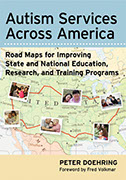 (2013). Autism Services Across America: Roadmaps for Improving State and National Education, Research, and Training Programs. Paul H. Brookes Publishing Co., Baltimore, MD
(2013). Autism Services Across America: Roadmaps for Improving State and National Education, Research, and Training Programs. Paul H. Brookes Publishing Co., Baltimore, MD
Guideposts
![]() Other Lessons Turning research into com-munity practice requires collaboration across researchers, practitioners, and agencies
Other Lessons Turning research into com-munity practice requires collaboration across researchers, practitioners, and agencies
![]() Other Lessons Weave funding, staffing, and training across partner agencies to control costs, ensure sustainability, and build your coalition
Other Lessons Weave funding, staffing, and training across partner agencies to control costs, ensure sustainability, and build your coalition
X
